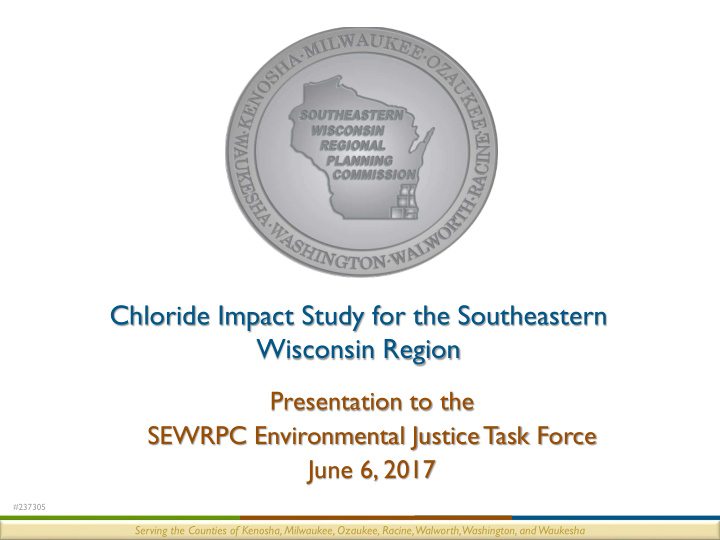



Chloride Impact Study for the Southeastern Wisconsin Region Presentation to the SEWRPC Environmental Justice Task Force June 6, 2017 #237305 Serving the Counties of Kenosha, Milwaukee, Ozaukee, Racine, Walworth, Washington, and Waukesha
Background March 2014 Commission Meeting • SEWRPC Commissioners identified public concerns about the environmental impacts of the use of road salt, particularly as they relate to inland lakes • Consensus of Commission that the staff should develop a prospectus to explore the conduct of a study addressing the environmental impacts of the use of road salt March 2014 to June 2015: Preliminary draft prospectus was prepared by the Commission staff March 2016: Prospectus was published 2 Serving the Counties of Kenosha, Milwaukee, Ozaukee, Racine, Walworth, Washington, and Waukesha
Purpose of the Prospectus Explore the need for a regional chloride impact study Recommend a potential scope and content of a study Propose a study schedule Recommend a budget Propose potential funding 3 Serving the Counties of Kenosha, Milwaukee, Ozaukee, Racine, Walworth, Washington, and Waukesha
Technical Advisory Committee Representatives from: Staffs of Milwaukee, Racine, Walworth, Washington, and Waukesha Counties Staffs of Cities of Brookfield, Cedarburg, Kenosha, Milwaukee, Muskego, and West Bend Milwaukee Metropolitan Sewerage District (MMSD) Wisconsin Department of Natural Resources (WDNR) Wisconsin Department of Transportation (WisDOT) Wisconsin Geological and Natural History Survey (WG&NHS) University of Wisconsin-Milwaukee School of Freshwater Sciences Marquette University Law School, Water Law and Policy Initiative U.S. Geological Survey (USGS) U.S. Environmental Protection Agency (USEPA), Region 5 Milwaukee Riverkeeper 4 Serving the Counties of Kenosha, Milwaukee, Ozaukee, Racine, Walworth, Washington, and Waukesha
Focus of Study Expanded from focus on road salt to consideration of other potentially significant sources of chloride to the environment: Road salt • Wastewater treatment plants • Private onsite wastewater treatment systems (e.g., septic systems) • Water softening (groundwater and surface water source) • Salt storage areas • Large agricultural feed lots • Fertilizers • Landfills • Chemical manufacturing • Food processing • 5 Serving the Counties of Kenosha, Milwaukee, Ozaukee, Racine, Walworth, Washington, and Waukesha
Need for the Study Water Samples Collected from Spring through Fall Acute toxicity criterion: 757 mg/l Chronic toxicity criterion: 395 mg/l 6 Serving the Counties of Kenosha, Milwaukee, Ozaukee, Racine, Walworth, Washington, and Waukesha
Impacts of Chloride Study would primarily address impacts on surface and groundwater resources • Streams, rivers, and lakes (effects on water quality and aquatic life) • Shallow groundwater aquifer, source of potable water for many communities and private wells in the Region and baseflow to streams, rivers, lakes, wetlands 7 Serving the Counties of Kenosha, Milwaukee, Ozaukee, Racine, Walworth, Washington, and Waukesha
Evidence of Chloride in Groundwater Serving the Counties of Kenosha, Milwaukee, Ozaukee, Racine, Walworth, Washington, and Waukesha
Analyses and Forecasts Compile existing data on chloride concentrations, specific conductance (surrogate for chloride), and streamflow Over a two-year surface water quality sampling period, deploy continuous recording data loggers to measure water temperature and specific conductance at 30 to 40 stream, river, and lake locations • Establish relationships between specific conductance and chloride concentration Sources of groundwater data • WDNR, USGS, UW-Stevens Point, and municipalities 9 Serving the Counties of Kenosha, Milwaukee, Ozaukee, Racine, Walworth, Washington, and Waukesha
Analyses and Forecasts Estimate chloride loads from: • Application rate information for roads as provided by counties, municipalities, and private applicators • Road salt sales information • Wastewater treatment plants • Private onsite wastewater systems • Other sources identified as being significant Compare applied loads to measured stream, river, and lake loads Develop chloride loads and concentrations for existing and planned year 2050 conditions Identify geographic areas with existing and/or planned high chloride loads 10 Serving the Counties of Kenosha, Milwaukee, Ozaukee, Racine, Walworth, Washington, and Waukesha
Analyses and Forecasts Evaluate effects of climate change on planned year 2050 road salt use • Precipitation and air temperature data developed for a range of mid-century climate change conditions • General predictions: − Higher winter night time air temperatures − More winter rain storms, fewer snow storms • Effects − Fewer events requiring road salt application − Applied road salt more quickly washed off land surface 11 Serving the Counties of Kenosha, Milwaukee, Ozaukee, Racine, Walworth, Washington, and Waukesha
Description of State-of-the Art of Activities Affecting Chloride in the Environment Examine various aspects of chloride sources in the environment Evaluate • Toxicity of anti-icing and deicing substances • Identify and evaluate best practices and technologies for: − Anti-icing and deicing − Water softening − Fertilizer application • Effects of chloride on transportation infrastructure Explore legal and policy aspects related to mitigating the effects of chloride on the environment (e.g., New Hampshire liability waiver) Develop performance and cost information for practices and management approaches 12 Serving the Counties of Kenosha, Milwaukee, Ozaukee, Racine, Walworth, Washington, and Waukesha
Alternative Chloride Management Scenarios Alternative anti-icing and deicing materials Alternative anti-icing and deicing practices Legal and policy aspects related to mitigating the effects of chloride Meet public safety objectives Minimize harm to environment Cost-effective 13 Serving the Counties of Kenosha, Milwaukee, Ozaukee, Racine, Walworth, Washington, and Waukesha
Recommend
More recommend